General Motors Business Model Canvas 2024
Although facing stiff competition from foreign automakers, General Motors, the largest American automaker that produces vehicles across a range of brands including Chevrolet, GMC, Cadillac, and Buick, continues to be an industrial and cultural icon representing American manufacturing and innovation for over a century. In this General Motors business model canvas, we will learn about its customer segments, value proposition, revenue streams, channels, customer relationships, key activities, key resources, key partners, and cost structure.
Interesting fact!
During WWII, GM stopped producing civilian vehicles and devoted over 85% of its production to building war supplies and equipment, including airplanes, trucks, tanks, and engines.
General Motors Competitors
Toyota | Volkswagen | Ford | Fiat Chrysler | Honda | Nissan | Hyundai | Tesla | BMW | Daimler
Customer Segments – General Motors Business Model Canvas
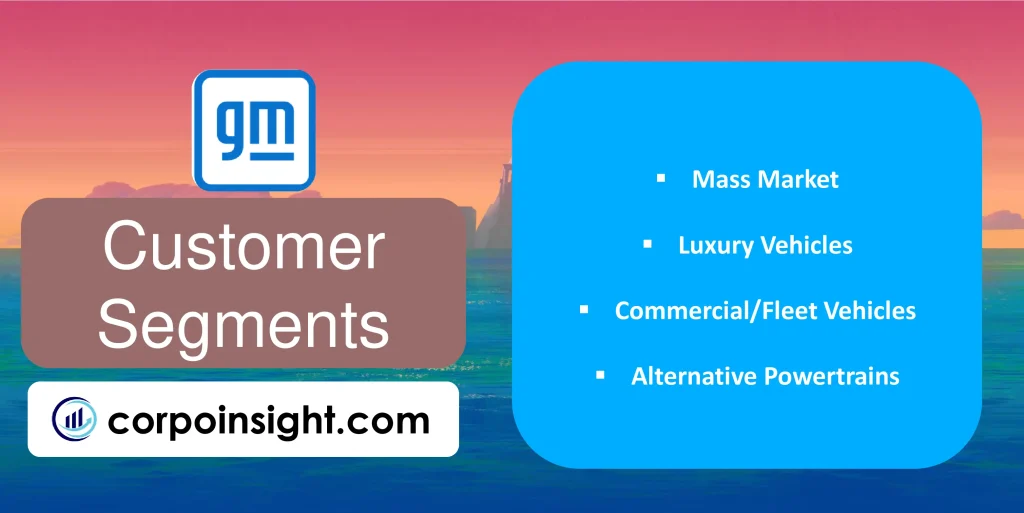
Mass Market: GM has a strong presence in the mass market segment with brands like Chevrolet, Buick, GMC, and Cadillac. Chevy’s best-selling vehicles, like the Silverado pickup and Equinox SUV, appeal to mainstream buyers looking for affordable and reliable transportation.
Luxury Vehicles: The Cadillac brand allows GM to compete in the global luxury market against the likes of Mercedes and BMW. Cadillac sold over 150,000 vehicles in 2018, including popular models like the XT5 crossover SUV.
Commercial/Fleet Vehicles: GM’s commercial and fleet sales, making up 19% of 2023 revenues, are supported by versatile vehicle offerings, including full-size vans, pickups, and medium-duty trucks suited for business applications. Top sellers are the Chevrolet Silverado and GMC Sierra pickups.
Alternative Powertrains: GM is expanding into electric and autonomous vehicles to keep pace with industry changes. The Chevrolet Bolt EV and Volt plug-in hybrid cater to environmentally conscious buyers looking for alternatives to gas-powered cars.
Value Proposition – General Motors Business Model Canvas
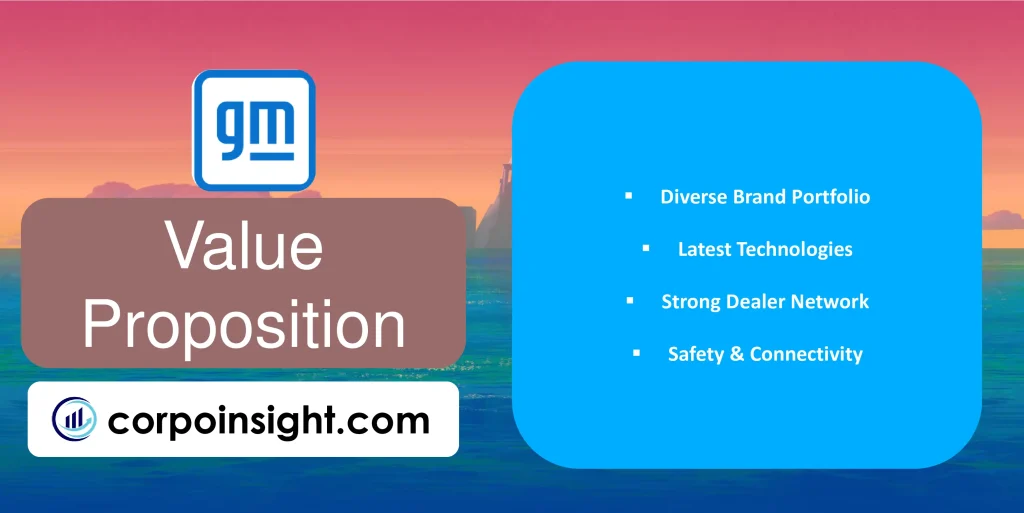
Diverse Brand Portfolio: GM offers vehicles across price points and styles, including economy cars, trucks, SUVs, and luxury vehicles. It lets them appeal to multiple demographics and preferences. For example, Cadillac sold over 150,000 vehicles globally in 2023 to compete with German luxury brands.
Latest Technologies: GM is investing heavily in electric and autonomous vehicle development. The Chevrolet Bolt EV provides 238 miles of electric range, and GM plans to introduce over 20 new EVs globally by 2023. Their Cruise self-driving subsidiary is testing autonomous taxis and delivery vehicles.
Strong Dealer Network: GM has over 4,500 dealerships across the US, providing sales and service support to customers locally. Its extensive reach helps GM maintain sales and brand awareness while dealers offer personalized customer service.
Safety & Connectivity: New GM vehicles come equipped with high-tech safety features and connected technologies. For instance, the 2020 Chevrolet Traverse SUV has a rear camera mirror, a teen driver system, and available in-vehicle WiFi to satisfy tech-focused buyers.
Revenue Streams – General Motors Business Model Canvas
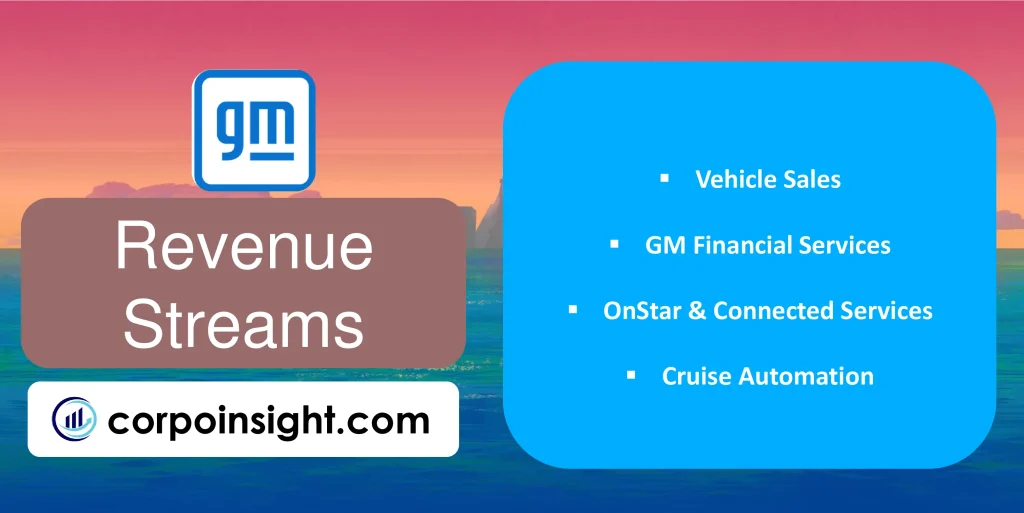
Vehicle Sales: GM earns the bulk of its revenues from the sale of new vehicles across brands like Chevrolet, GMC, Buick, and Cadillac. In 2023, 72% of $147 billion in revenues came from vehicle sales in North America and international markets. Flagship brands like Silverado pickup drove strong sales.
GM Financial Services: GM’s financing arm provides loans and leasing options to customers and dealers to support sales. They contributed over $1 billion in earnings in 2023. Services like 0% financing deals on new vehicles helped improve vehicle affordability.
OnStar & Connected Services: OnStar safety and security services have over 1.5 million subscribers. Connected infotainment options like in-vehicle WiFi also provide recurring subscription revenues. Such services made up 12% of earnings in 2023.
Cruise Automation: GM’s Cruise self-driving subsidiary is developing autonomous taxis and delivery vehicles, with plans to launch commercial driverless ride-hailing in 2023. It represents potential for new revenue streams via robotaxi services in the future.
Channels – General Motors Business Model Canvas

Dealerships: GM has over 4,500 dealerships across the US that are the main retail channels for new vehicle sales and service. They offer test drives and provide localized marketing and inventory. Dealers accounted for the majority of GM’s retail sales in 2023.
Online Channels: GM operates regional websites for shoppers to research models, view inventory, get price quotes, and schedule test drives. They also enable online purchasing options in many markets for added convenience.
Third-Party Sites: GM partners with major online automotive retailers like Carvana and Vroom, which provide additional online channels for customers to purchase and finance used vehicles.
Direct to Consumer: GM’s smaller-scale Launchpad distribution channel sells vehicles directly to consumers, starting with the electric Chevrolet Bolt. It allows GM to control sales process and pricing versus indirect dealer channels.
Customer Relationships – General Motors Business Model Canvas
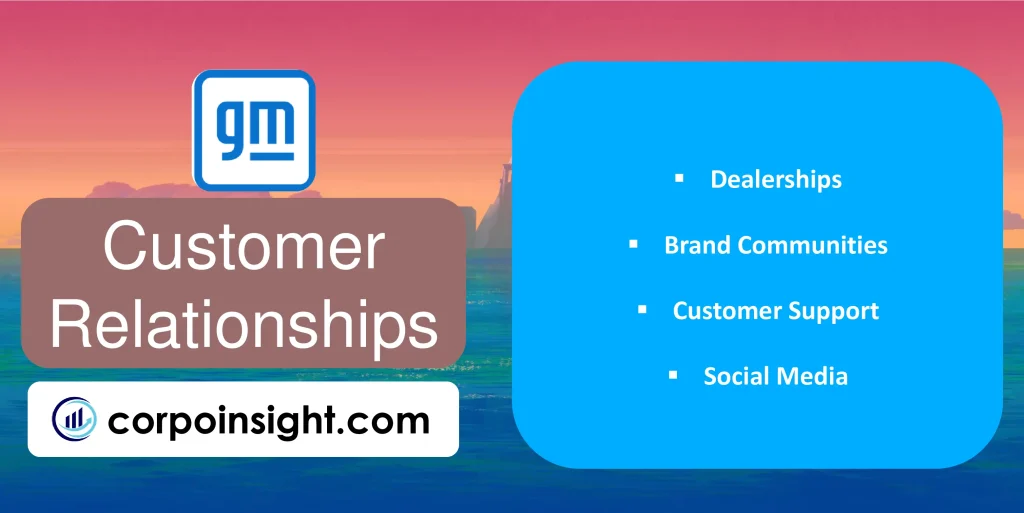
Dealerships: GM’s network of over 4,500 dealers in the US provides a localized sales and service experience. Dealers aim to establish long-term relationships with customers in their communities via test drives, maintenance, and personal interactions.
Brand Communities: GM cultivates brand loyalty and connections through Chevrolet, Buick, and Cadillac owner clubs and enthusiast events. It fosters brand engagement and word-of-mouth promotion.
Customer Support: GM provides 24/7 phone and online customer support via channels like OnStar to address issues, provide product information, and receive feedback. Their rating on customer service satisfaction is comparable to competitors.
Social Media: GM brand pages on Facebook, Twitter, and Instagram allow customers to interact directly. Social platforms are used for targeted promotions and to showcase innovation. GM’s Instagram has over 1 million followers.
Key Activities – General Motors Business Model Canvas
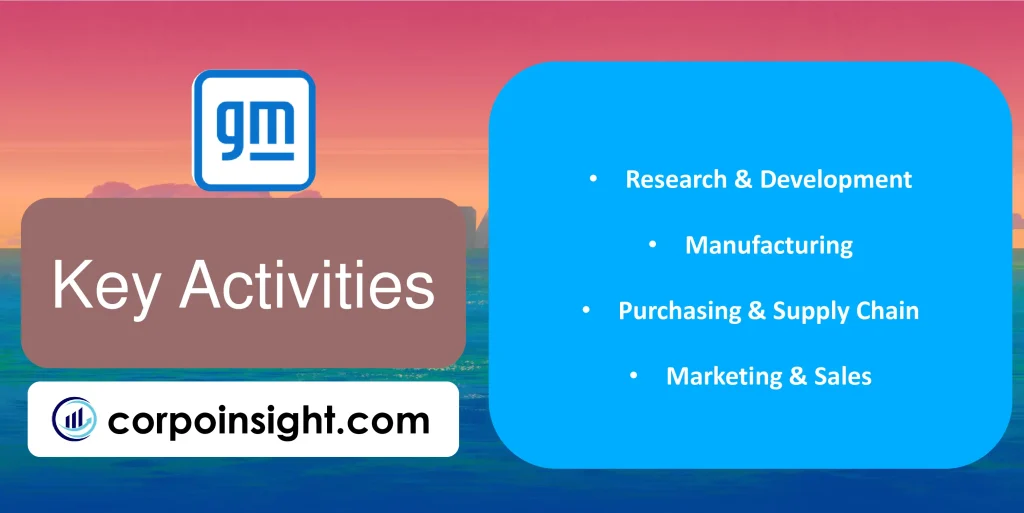
Research & Development: GM invests heavily in R&D to enhance vehicle technology, efficiency, and performance. They spent $8.1 billion on R&D in 2023 to fund projects like electric and autonomous vehicle development at the GM Cruise subsidiary.
Manufacturing: GM operates over 30 manufacturing facilities in the US and worldwide to assemble vehicles and components. Their flexible manufacturing processes produce a range of cars and trucks across brands and segments.
Purchasing & Supply Chain: GM coordinates with a global network of thousands of Tier 1 suppliers who provide vehicle parts and materials for assembly. Managing this complex supply chain is critical to operations.
Marketing & Sales: GM spends billions on advertising and consumer incentives to drive sales through dealer networks. Chevrolet alone budgets over $3 billion in US advertising annually. Brand positioning and incentive offerings are strategically managed.
Key Resources – General Motors Business Model Canvas
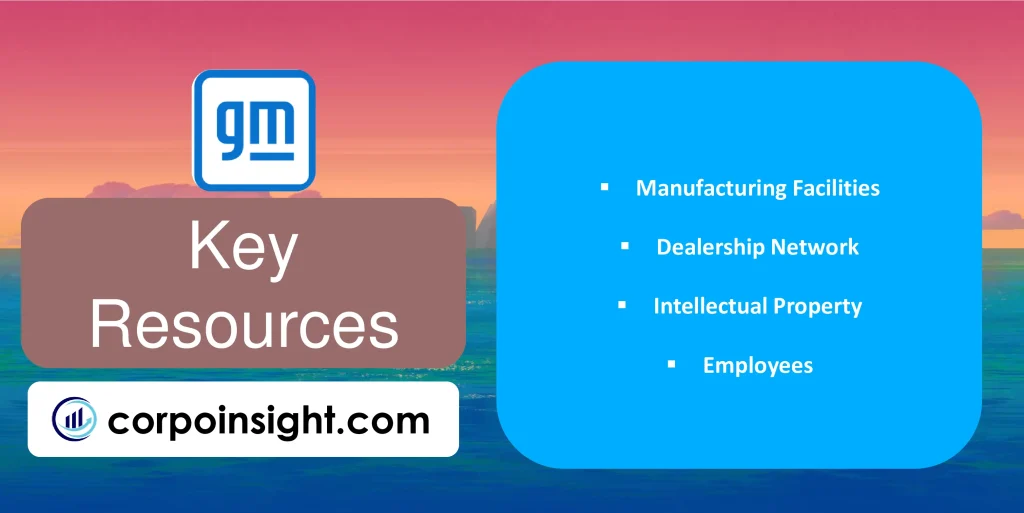
Manufacturing Facilities: GM has an extensive network of over 30 vehicle manufacturing facilities, component plants, and engineering centers worldwide. These enable large-scale production across brands and geographies.
Dealership Network: GM’s authorized dealer network includes over 4,500 dealerships in the US Dealers provide sales and service access points nationwide to support GM’s retail business.
Intellectual Property: GM invests heavily in R&D, with over 14,000 patents worldwide on technologies ranging from battery chemistry to autonomous systems. Their IP portfolio gives them an edge in key innovations.
Employees: GM employs over 164,000 people globally, including thousands of engineers and designers. Their human talent supports manufacturing expertise, brand marketing, R&D, and global operations.
Key Partners – General Motors Business Model Canvas
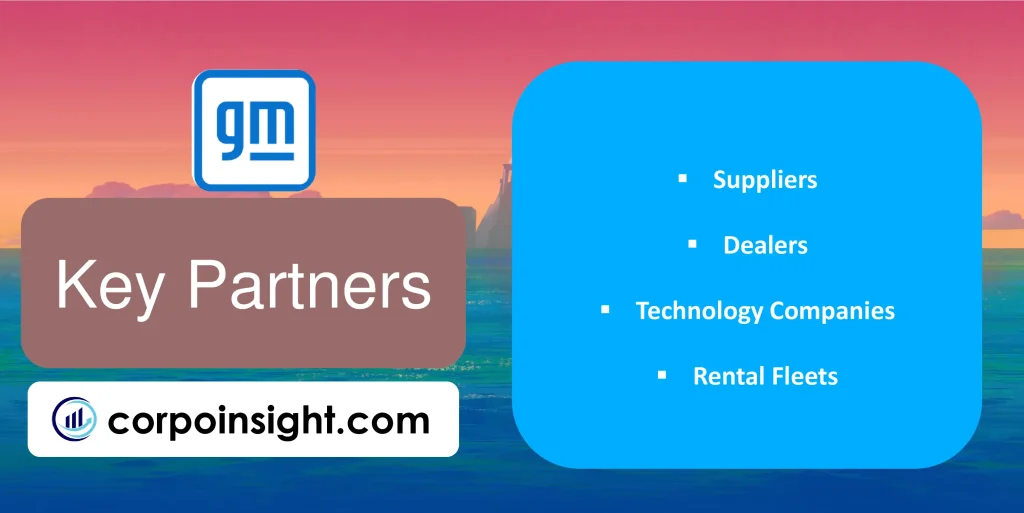
Suppliers: GM maintains partnerships with thousands of Tier 1 parts suppliers who provide components and materials for vehicle manufacturing. Top suppliers include Magna International, LG, and Continental AG.
Dealers: GM’s network of over 4,500 authorized dealers in the US are key partners responsible for new vehicle sales and after-sales service. Dealer partnerships are critical for GM’s retail distribution.
Technology Companies: GM partners with technology firms like Microsoft and Honda on the development of electric and autonomous vehicles. These help GM integrate the latest innovations into new models.
Rental Fleets: Key fleet partnerships with rental companies like Enterprise and Hertz boost high-volume commercial vehicle sales for GM. Over 1 million GM vehicles are in rental fleet use annually.
Cost Structure – General Motors Business Model Canvas
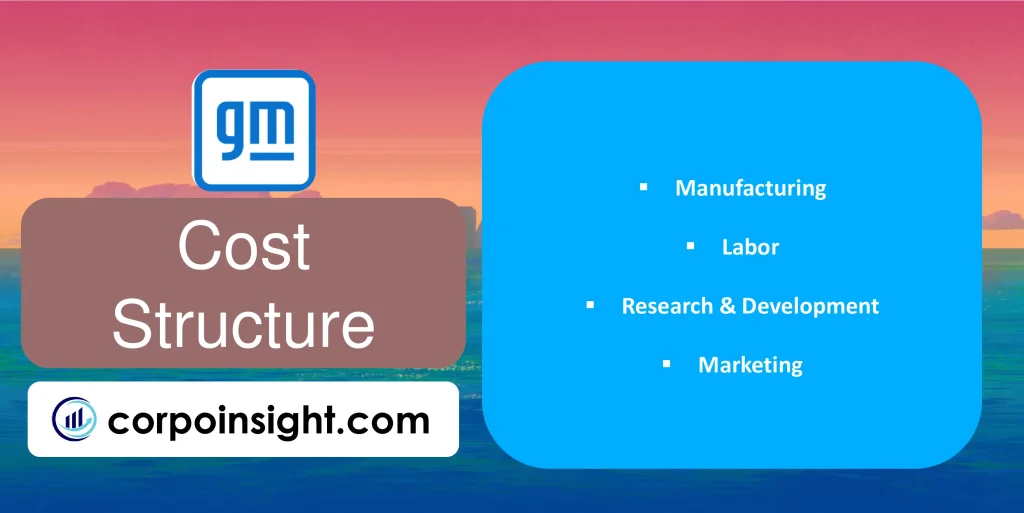
Manufacturing: GM spends heavily on manufacturing costs, including raw materials, components, labor, and facilities, to produce over 6 million vehicles annually. For example, steel and aluminum prices impact vehicle bill of materials.
Labor: GM employs over 164,000 people globally. Employee compensation and benefits account for a significant portion of operating costs. Recent restructuring actions aim to optimize labor expenses.
Research & Development: GM invested $8.1 billion in R&D in 2023 to develop new vehicles and technologies like electric and autonomous. R&D spending reflects their focus on innovation leadership.
Marketing: Advertising and consumer incentives are key to driving new vehicle sales through dealers. Chevrolet alone has an estimated $3 billion US ad budget. Promotional costs directly impact sales volumes.
Summary of General Motors Business Model Canvas
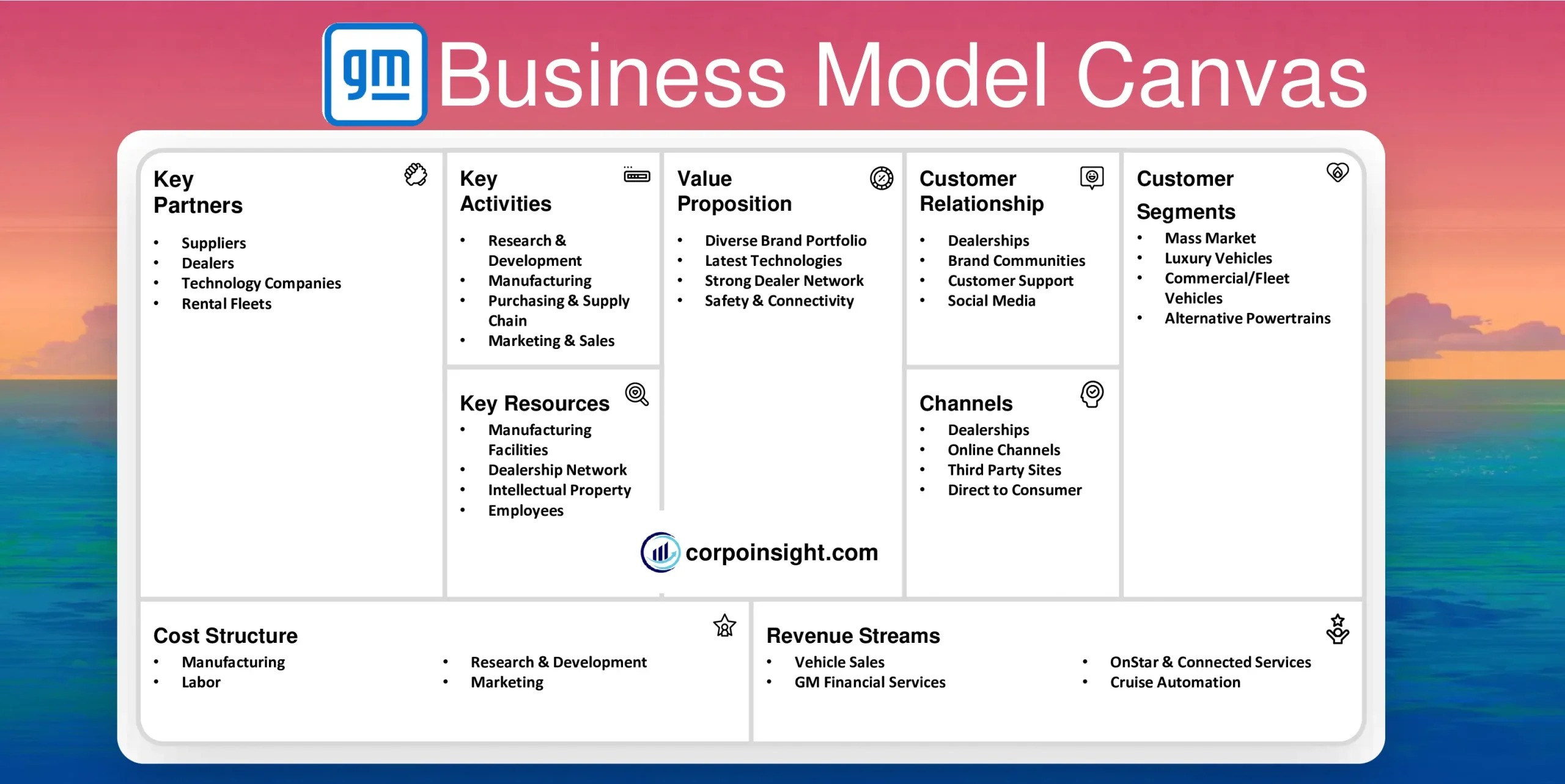
Conclusion on General Motors Business Model Canvas
General Motors maintains a diverse brand portfolio spanning mass market and luxury segments, leveraging its extensive manufacturing capabilities, dealer network, and investments in R&D to deliver a wide range of vehicles. Despite facing competition, GM’s scale, manufacturing expertise and focus on new technologies around electrification and autonomy provide the foundation to adapt its business to emerging trends in mobility and transportation.

This is Ahsanul Haque, someone very passionate about digital marketing, SEO, and Data Analytics and founder of the Analytics Empire and currently pursuing my major in marketing at Bangladesh University of Professionals.






